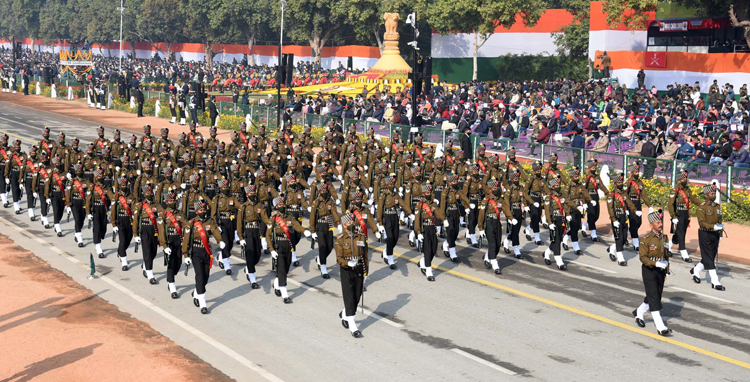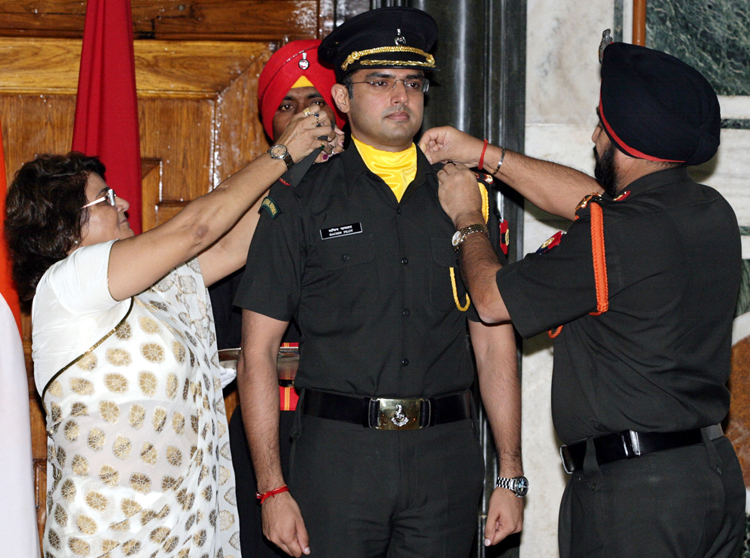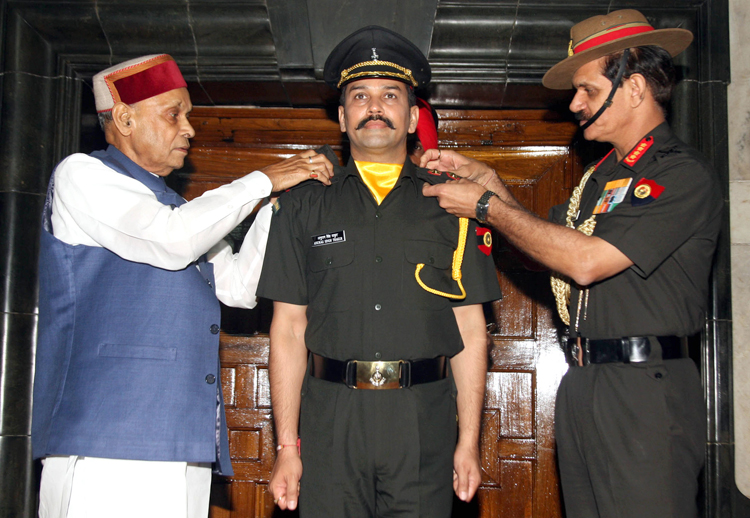INDIAN ARMED FORCES CHIEFS ON
OUR RELENTLESS AND FOCUSED PUBLISHING EFFORTS

SP Guide Publications puts forth a well compiled articulation of issues, pursuits and accomplishments of the Indian Army, over the years

I am confident that SP Guide Publications would continue to inform, inspire and influence.

My compliments to SP Guide Publications for informative and credible reportage on contemporary aerospace issues over the past six decades.
- Prime Minister witnesses 'Bharat Shakti' – a Tri-Services Firing and Manoeuvre Exercise in Pokhran, Rajasthan
- Interim Defence Budget 2024-25 — An Analysis
- Union Defence budget 2024
- Prime Minister Modi Commemorates Indian Navy Day in a Grand Ceremony
- Prime Minister Modi Flies in the LCA Tejas
- New Chapter in India-Italy Defence Ties
- Airpower beyond Boundaries
The Territorial Army
TA units were actively involved in military operations in 1962, 1965 and 1971. The Terriers have also participated in Operation 'Pawan' in Sri Lanka, Operation 'Rakshak' in Punjab and J&K, Operation 'Rhino' and Operation 'Bajrang' in the northeast. Departmental units came to the aid of the civil authorities during industrial unrest and natural calamities like the earthquake in Latur (Maharashtra). Uttarkashi in Garhwal (Uttrakhand) and the super cyclone in Odisha.
 |
The Author is Former Director General of Information Systems and A Special Forces Veteran, Indian Army |

The Territorial Army (TA) is a volunteer reserve force of the Indian Army. Also called Terriers and hailed as part of the part time commitment, full time honour, it is meant for citizens who are already employed in mainstay civilian professions. In fact gainful employment or self-employment in a civil profession is a prerequisite for joining the Territorial Army. Volunteers of the Territorial Army usually serve in uniform for 2-3 months every year, so that they can bear arms for national defence in times of dire need or national emergencies.
The TA has a present strength of approximately 40,000 first line troops and 1,60,000 second line troops. A TA officer can get permanent commission based on the time period he serves in a year, performance and choice of course. On completion of 20 years of physical service for officers and 15 years for JCOs and below, other than civil government employees, family/disability pension is also admissible as applicable to the regular Army.
Volunteers of the Territorial Army usually serve in uniform for 2-3 months every year, so that they can bear arms for national defence in times of dire need or national emergencies
On September 6, 2012, Sachin Pilot became the first Union minister of India to be commissioned as an officer in the TA. On March 12, 2014, Karnataka’s senior IAS officer P. Manivannan with 15 years in IAS was commissioned in the TA with a rank of Lieutenant in 106 Infantry Battalion (TA). In March 2021, Anurag Thakur, then Minister of State Finance & Corporate Affairs was promoted to the rank of Captain in 124 Infantry Battalion TA. In July 2016, he had been commissioned in the same unit by then Army Chief General Dalbir Singh Suhag.

Such reports are periodic in the case of politicians and sports personalities also but beyond the media blitz at the pippin ceremony, do they serve in the TA unit every year for 2-3 months at least as required. The answer is no because if they were doing so they would have ensured full media glare on to themselves. Have Sachin Pilot and Anurag Thakur been serving the 2-3 mandatory months in TA annually or is it all on paper with the military chiefs and hierarchy doing this to curry favor with politicians? What about the likes of Tendulkar?

In recent months three news items have appeared in media concerning the Territorial Army (TA), also known as Terriers. News reports of June 6, 2022, said that out of the six Railway TA Engineer Regiments located at Jamalpur, Jhansi, Kota, Agra, Chandigarh and the Secunderabad, five are to be disbanded. The Railway TA Engineer Regiment located at Jamalpur is to be retained for the operational role along the route New Jalpaiguri-Siliguri-Newmal-Alipurduar-Rangiya (361 km) covering the rail link through Siliguri corridor and further up to Rangiya. The decision has been taken by the Ministry of Railways in conjunction with the Ministry of Defence (MoD).
With all the current talk of disciplining the nation, desh bhakti, we need to take a holistic call on the concept of TA – to expand and optimise it
The disbandment process of the above five Railway TA Engineer Regiments is to be completed by the Directorate General of Territorial Army (DGTA) within a duration of nine months from the date of issue of Ministry of Railways letter dated June 6, 2022 (by March 6, 2023), and the modalities for the same are to be worked out by the DGTA in consultation with the Ministry of Railways and the MoD.
The second news item related to the TA is tragic. News reports of June 30, 2022 stated that a massive landslide hit the Army’s 107 Territorial Army (TA) camp in Noney District of Manipur and among the dead were eight TA jawans – a figure which reportedly rose later to almost double. At least one among them was a Railway worker engaged in the construction of the Imphal-Jiribam railway project. The TA unit was deployed near Tupul Railway Station in Noney District for protection of the under-construction railway line.
The third news item of July 11, 2022, is about Army wanting to induct Mandarin-trained officers in the TA. The Army issued a notification on July 10 inviting applications. The initial plan is to recruit five civilian candidates and one ex-serviceman through this notification. The Army is making efforts to improve Mandarin language training and knowledge of Tibetology to empower junior and senior military commanders to engage with People’s Liberation Army (PLA) when the situation arises.
There is no reason why lawmakers and the IAS cannot do 2-3 months training annually in the TA. The IFS can do such training during the India posting.
The Silchar-Imphal rail link along with widening of NH 37 is an extension of Lumding-Silchar broad gauging which commenced in late 1990s. Earlier, this work was held up with barely one work session a day and long breaks due to raging militancy and extortion. Last year the first Train reached Manipur going further ahead of Jiribam which saw the first train in 2016. The role of TA, specially 107 Infantry Battalion TA and 109 Infantry Battalion TA Assam has been significant in ensuring these developments.
Ironically, these two TA battalions never got the recognition they deserved. According to sources, the Railways have done shoddy work in laying the railway track. This year there were 52 landslides in the Lumding-Silchar belt in May itself which impacted rail traffic. Noney witnessed landslides last year also. But the pride in these two TA Battalions runs high, ‘Savdhani Va Shoorta’ is the motto of Terriers as they continue to work tirelessly for the development of the nation. Some recognition for them is more than due.
With all the current talk of disciplining the nation, desh bhakti, we need to take a holistic call on the concept of TA – to expand and optimise it. The modern Territorial Army was inaugurated by the first Indian Governor-General of India, C. Rajagopalachari, on October 9, 1949 after the Independence Territorial Army Act was passed in 1948. Countries like the UK, Ethiopia and Malaysia follow the TA concept. Territorial Army (Germany) was part of the West German Army during the Cold War. In units of the Japan Self Defence Forces, manpower in one sub-unit comes from the corporate by rotation while the weaponry and equipment are held by the unit concerned.
If we truly want India to be great, participation in the TA should begin from the top to fire the national spirit. There is no reason why lawmakers and the IAS cannot do 2-3 months training annually in the TA. The IFS, with two foreign tenures followed by one in India can do such training during the India posting. The corporate and the rest of the public will automatically follow suit. This would be far better than depriving youth from higher education and sending them to do four-year service in the military.





